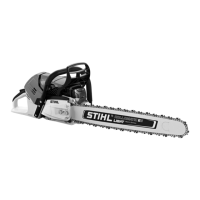0458-809-0121-A
26
English
11 Operating the Saw
► If the tree has large, healthy buttress roots: Make vertical
cut first and then a horizontal cut, and remove the
resulting piece.
11.5.3 Basic information on felling cut
C Felling notch
The felling notch determines the direction of fall.
D Hinge
The hinge helps control the falling tree. The width of the
hinge is 1/10 of the trunk diameter.
E Felling cut
The tree is felled with the felling cut. The felling cut is
1/10 of the trunk diameter (at least 3 cm) above the
bottom of the felling notch.
F Stabilizing strap
The stabilizing strap supports the tree and helps prevent
it from falling prematurely. The width of the stabilizing
strap is 1/10 to 1/5 of the trunk diameter.
G Holding strap
The holding strap supports the tree and helps prevent it
from falling prematurely. The width of the holding strap is
1/10 to 1/5 of the trunk diameter.
11.5.4 Cutting the felling notch
The felling notch determines the direction in which the tree
falls. Country-specific standards for making the felling notch
must be observed.
► Position the saw so that the felling notch is an right angles
to the direction of fall and the saw is close to the ground.
► Make the horizontal cut.
► Make the angle cut at 45° to the horizontal cut.
► If the wood is sound and long-fibered: Observe the
following points when making sapwood cuts:
– The cuts must be the same at both sides.
– The cuts must be at same height as bottom of felling
notch.
– The width of the cuts is 1/10 of the trunk diameter.
The trunk does not splinter when the tree falls.
11.5.5 Plunge cutting
Plunge cutting is a technique required for felling.
Ø
1/10
0000-GXX-1251-A1
C
C
E
G
0000-GXX-1249-A0

